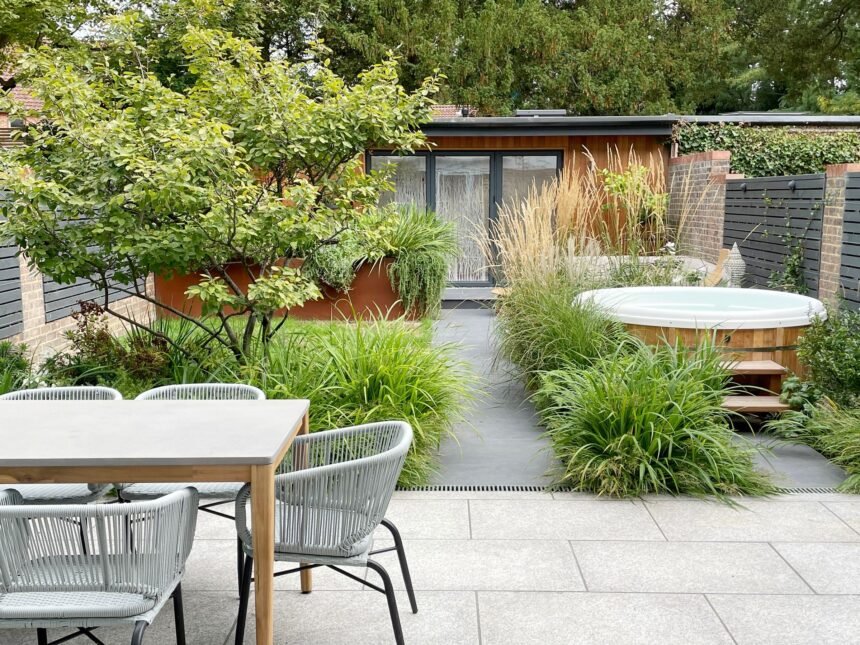A beautiful outdoor space isn’t just for spring blooms or summer evenings. With the right approach, your garden and patio can remain inviting throughout the year. The secret lies in planning with all four seasons in mind—understanding how plants, furniture, and maintenance work together to create a seamless flow from one season to the next.
The truth is, your outdoor space doesn’t have to lose its charm when temperatures drop or rise. With a few simple strategies, you can make your garden and patio both resilient and breathtaking—no matter what the weather decides to do.
Spring: Refresh and Reinvigorate
Spring is the season of revival. It’s when your garden wakes up, and your patio starts to see more daylight. Begin by clearing away winter debris—fallen leaves, broken branches, and any leftover clutter that dulls the space. Once everything is clean, turn your attention to the soil.
Adding compost or organic matter helps your plants thrive as the ground warms. Focus on pruning shrubs and trees before new growth begins. Early preparation ensures strong, balanced growth that lasts through the warmer months.
For the patio area, give furniture a quick inspection. Wipe down tables and chairs, tighten any loose screws, and replace worn-out cushions. Introduce pops of color with potted spring flowers like tulips, daffodils, or pansies. These early blooms create instant cheer and signal the start of outdoor living once again.
Summer: Sustain, Shade, and Simplify
By summer, your outdoor space is in full swing—but it’s also when maintenance becomes crucial. Heat and humidity can take a toll on plants, so consistent watering and mulching are key. Mulch not only locks in moisture but also helps suppress weeds, keeping your garden low-maintenance and neat.
Consider investing in drip irrigation systems for efficiency and water conservation. This small upgrade ensures plants receive steady moisture without waste. Grouping plants with similar watering needs also simplifies your routine.
Shade becomes your best friend during this season. Pergolas, umbrellas, or natural shade from trees can make your patio far more enjoyable. If you’re considering adding or upgrading your deck to include shaded areas or built-in seating, consult experienced deck builders who can tailor the design to fit both your style and the climate.
Your furniture and accessories matter, too. Choose breathable fabrics for cushions and add light throws for evening comfort. A balance of greenery, structure, and shade turns your backyard into a cool, welcoming retreat.
According to Better Homes & Gardens, the right combination of shaded areas and weather-resistant materials can extend your outdoor season well into late fall.
Autumn: Prepare and Preserve
Autumn is nature’s transition phase—a time to prepare your space for colder months while still enjoying its beauty. The fading colors of leaves create a warm backdrop that naturally enhances your garden’s charm.
Begin by deadheading summer flowers and trimming perennials. This keeps the garden tidy and encourages healthier regrowth in spring. Fall is also the ideal time to plant bulbs that will bloom early next year. Think ahead—plant tulips, crocuses, or hyacinths now for a burst of color when winter fades.
For your patio, clean and seal wooden surfaces to protect them from moisture and frost. Store or cover outdoor furniture to prevent damage, especially if you live in an area with heavy rain or snow. Introduce cozy elements like lanterns, string lights, and fire pits to extend outdoor gatherings into cooler evenings.
Autumn is also the best time to rethink layout. If you’ve noticed traffic patterns or underused areas, rearrange furniture or reposition planters to improve flow. These subtle changes make a big difference when spring rolls around again.
Winter: Protect and Add Warmth
Winter doesn’t have to mean a barren backyard. While it’s true that many plants go dormant, you can still create structure and visual appeal. Focus on evergreens, ornamental grasses, and textured shrubs that maintain interest even in colder months.
Use raised beds or container gardens with hardy winter plants like holly, boxwood, or winter jasmine. Their color and structure will keep your garden from feeling lifeless. Lighting also becomes more important in winter. Warm-toned LED or solar lights add depth, guiding the eye and bringing a soft glow to frosty evenings.
If your climate allows, keep the patio partially functional. All-weather furniture, waterproof cushions, and a small outdoor heater can transform it into a cozy retreat for morning coffee or evening reflection. Even a small covered corner can feel like an escape from the cold.
Creating Continuity Across Seasons
Maintaining beauty year-round is less about perfection and more about rhythm. Each season builds on the last, creating continuity. What you prune in spring strengthens summer blooms; what you plant in fall sets the stage for next spring’s color.
One way to ensure that rhythm is through thoughtful design. Use color themes that transition naturally from season to season—pastels in spring, vibrant tones in summer, warm hues in fall, and neutrals in winter. This consistency ties the space together even when individual elements change.
Furniture and decor can follow the same principle. Keep a base set of timeless, durable pieces, and swap out smaller accents like cushions, pots, or lanterns to reflect the season’s mood. This approach minimizes cost and effort while maximizing impact.
Final Thoughts: Lasting Beauty, Every Month of the Year
A truly gorgeous outdoor space isn’t defined by the season—it’s defined by care and creativity. By maintaining balance between design and maintenance, you ensure your garden and patio remain a place of comfort and beauty all year long.
With a little foresight and regular upkeep, the transformation from spring to winter becomes seamless. You’ll spend less time worrying about what’s next and more time enjoying the outdoor haven you’ve built.
Because when each season brings something special, your garden and patio never really go out of style—they just change with the rhythm of life.









